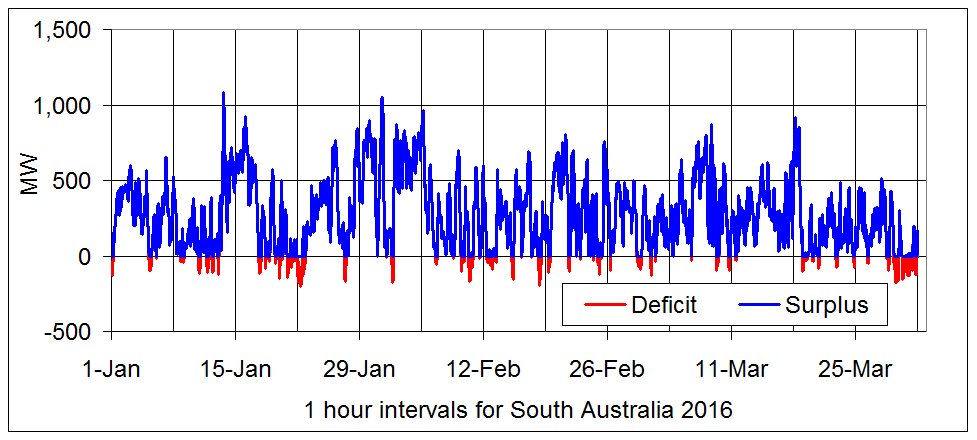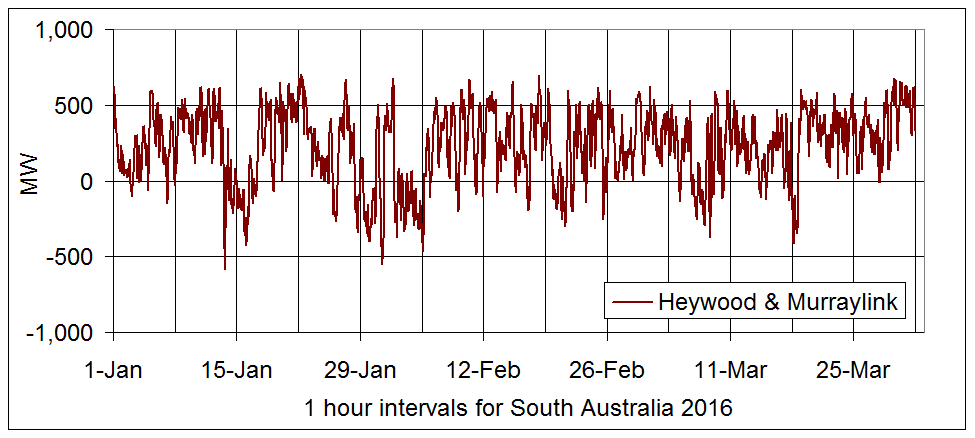The result of adding another 250 MW power station is shown in Figure 4 in matching the demandformerly supplied by the interconnectors.

Figure 4:Variations of surplus and deficit from two 250 MW power stations operating continuously to meet the demand formerly supplied by the interconnectors for January to March 2016
Advertisement
There are very large surpluses of energy if the two power stations run continuously at maximum output. However the battery storage performance shown in Figure 5 indicates that matching the energy deficits requires only 2.5 GWh of storage so one of the two power stations would operate as a peaking generator. A peaking station is used to make up for sudden increase in demand and to recharge the battery storage to a maximum, another intermittent function. On the January to March period the utilisation would be 36% for the peaking generator and 68% for the "baseload" generator.
In fact 2.5 GWh of storage comes at a greatly reduced cost of $500 million at $0.20 per Wh compared to the $10 billion of storage costs with one 250 MW power station.

Figure 5:Battery storage behaviour to match demand formerly supplied by the interconnectors with two 250 MW power stations.
As an aside, if a complete shutdown of the sort experienced on 28 September 2016 occurred again then some 7 GWh of storage would be needed as well as the two 250 MW power stations.
The cost of one power stations of 250 MW is $360 million (government estimate) and $500 million for the batteries gives a total initial spend of $860 million from the South Australian government on behalf of its taxpayers. But even worse the government funded power station would run as a peaking station and would have little chance of making any profit as a result of low utilisation and government constraints on bidding into a wholesale electricity market where a high price would be expected. How battery discharges would be priced is an interesting question, Meanwhile the industry funded 250 MW power station might need to be financially encouraged.
Advertisement
The choice of batteries is "quixotic" as an additional 250 MW power station would need no back up storage and at $360 million would be an apparent bargain.
So the South Australian government plan has a mad logic to it but it requires two power stations in addition to its fashionably-chosen, unspecified amount of battery storage. As shown in this analysis, the proposed amount of battery storage, an amount that can only be gleaned from the cost estimate provided, and seems to be a touted 500 MWh, (0.5 GWh) to be consistent with the government plan but not the requirement of 2.5 GWh. In fact the battery need is probably larger as there are limits to battery discharge levels that might double the storage size and cost.
Of course there were two power stations that could have supplied this power. But they have been closed and a baseload power station cannot operate commercially with 40% intermittent wind and solar power.
Discuss in our Forums
See what other readers are saying about this article!
Click here to read & post comments.
20 posts so far.